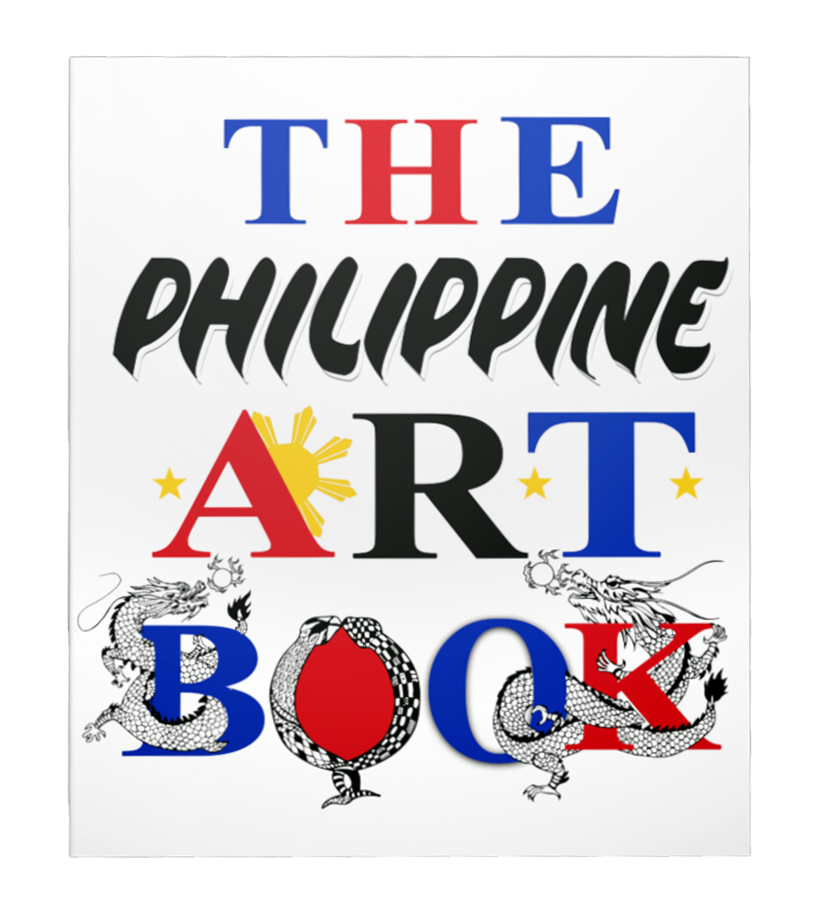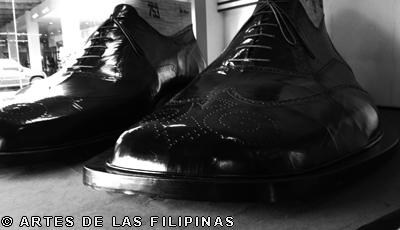
The History of Marikina’s Shoe Industry
by: Nonet Angeles
I. Basic Information About Marikina
Marikina was founded three hundred righty-three years ago when the Jesuits arrived in 1630. They called the area Jesus dela Peña (Jesus of the Rocks). It was later called Mariquina and a parish was established there in 1687. Fishing and farming were the main source of livelihood. In 1901, the town was officially named Marikina by the First Philippine Commissioner, Trinidad Pardo de Tavera replacing the Hispanidad “q” with the vernacular “k”. Later in 1977, the town was officially made a part of the newly-created Metro Manila area.
The significant year for Marikina was in 1887. It was in this year when shoemaking started to flourish through the efforts of Don Laureano "Kapitan Moy" Guevarra. From this year, the growth of the place economically becomes dynamic due to shoemaking. Today, Marikina is one of the sixteen (16) cities and a municipality of Metro Manila. It was proclaimed a city through the Republic Act 8223 on December 8, 1996. It is a multi-awarded metropolitan city, often cited for its vibrant economy, highly-skilled and literate work force, involved and enlightened business community and responsive local government that puts a premium on governance, sustainable urban development and public service. It is also one of the healthiest cities in the Asia-Pacific region, winning at least seventy-eight awards and recognitions both local and international in a span of twelve years.
Today, Marikina is known as the Shoe Capital of the Philippines because of its progressive shoe industry. It is also the home of the world’s largest pair of shoes certified by the Guinness Book of World Records. Furthermore, the Shoe Museum preserved most of the famous shoes of former First Lady Imelda Marcos. The city also prides itself of cultural and heritage site, Kapitan Moy, the ancestral house of the Father of the Shoe Industry in the Philippines, Don Laureano Guevara and other numerous tourist sites.
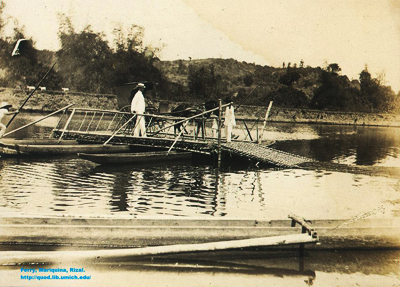
The Marikina River
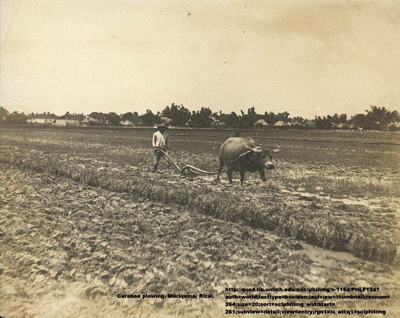
A Rice Field in Marikina
a. Geography
Marikina, a lush valley bounded by mountain ranger and sliced by a river, is one of the sixteen cities and a municipality that comprised the Metro Manila area. It is approximately twenty-one kilometers away from Manila and it lies within 14°35’ latitude and 14°41’ longitude.
It is bounded on the east by the Sierra Madre Mountains and Antipolo City; on the west by the hills of Quezon City; on the north by San Mateo and on the south by Pasig City and the municipality of Cainta.
Statistical Summary as of 2012
Land Area : 21.5 sq. km.
No. of District : 2
No. of Barangays : 16
Population Density : 23,828
Population : 513,370
Household Population : 108,958
Household Size : 4.71
Crude Birth Rate : 24.33%
Crude Death Rate : 7.29%
Infant Mortality Rate : 11.54/1,000
Morbidity Rate : 91.45/1,000
Maternal Mortality Rate : 1.81/1,000
Income : 1.537B
Primary Industry : Shoemaking
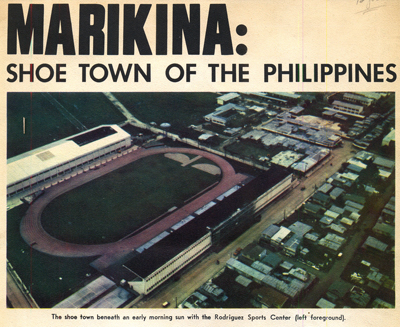
II. The Marikina City’s Footwear Industry
One of the significant factors that aid the success of Marikina’s footwear industry is hard work, inventiveness and dedication of each shoemaker to the craft and passing their knowledge to succeeding generations. Marikeños have regarded shoemaking as a way of life and because of this it yielded a million dollar revenue during its prime years. Another factor to consider is the growing acceptability of Philippine-made footwear in local and international markets, coupled with the perseverance of the industry and local leaders in promoting the product amidst the many challenges it faced.

Don Laureano “Kapitan Moy” Guevarra (1851-1891)
a. The Humble Beginnings and Notable Developments
The shoemaking industry began in 1887 through the pioneering efforts of Don Laureano “Kapitan Moy” Guevara. He was assisted by Tiburcio Eustaquio, Ambrocio Sta. Ines, and Gervacio Carlos. Kapitan Moy, a highborn and a community leader who had bought himself a pair of imported shoes during one of his trips to Manila. He used this pair of shoes as an example for his workers to study and duplicate. They dissected its various parts and by trial and error, they learned how to put them back together. That afternoon, Kapitan Moy and his shoemakers had their onlookers. A group of young boys had been craning their necks to watch the whole episode through a grilled window. Pablo de la Paz who was among the onlookers narrated the same episode to his children, claiming that shoemaking began in 1888 when he was fourteen of age. Kapitan Moy saw to it that other Marikeños were taught the skills of shoemaking as he intended it as a source of livelihood in the town aside from the main activities of fishing and farming. Because of this, he was given the title “Father of the Shoe Industry.”

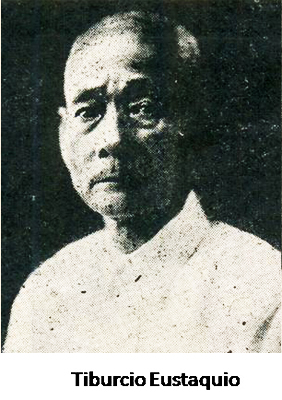
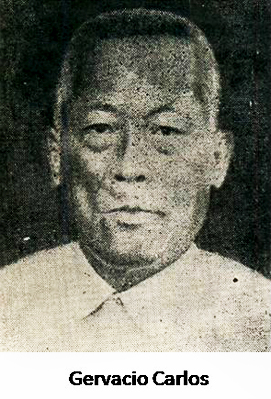
Shoe manufacturing by way of machinery was introduced to Marikina during the American occupation. In 1898, the American occupation troops in the country placed orders for army shoes. This prompted the American soldier, R.R. McGuire to establish a shoe factory using the machinery. McGuire eventually set up the United States Shoe Company, a firm which later became the Hike Shoe Palace. The Hale Shoe Factory or Esco Shoe Company was later organized under the leadership of Mr. Hale. At about the same time, the Ang Tibay Shoe manufacturing firm was founded by Toribio Teodoro who pioneered the manufacturing and distribution of machine-made shoes. The People’s Shoe Company, on the other hand, was engaged in the mass production of machine-made shoes.
1930s – 1940s
In 1935, Marikina already had 139 shops producing 260,078 pair of ladies shoes and 86,692 pairs of men shoes worth Php 762,896.00, and as many as 2,450 citizens were directly engaged in the industry either as shoemakers or uppermakers. Manila was the prized market for the shoes made by Marikeños. Shoemakers had to deal with the Chinese merchants who held forth in Gandara, Nueva and other parts of Chinatown. Marikeños, with their craftsmanship and little shops had no choice but to enter into a partnership with the Chinese who had their stores and bundles of raw materials. It was an unequal partnership that endured for generations since Chinese could dictate the price of finished shoes as well as raw materials.
In 1936, the Marikeños lost their patience and took a stand. Through “Oras Na” (The Hour is Now), a worker’s union organized by Mayor Wenceslao de la Paz, they pledged unity to not sell shoes to the Chinese nor buy any raw materials from them. The union members prevented shipment of shoes to Manila by barricading the Barangka Highway, the only road that linked the place. They also avoided shoes from the neighboring town of San Mateo to be delivered to Chinese middlemen. Though the union showed sympathy to local authorities, they could not outlast the moneyed Chinese merchants. Having made their statement for a better deal, the members of the union returned to work.
Since the beginning, Marikeños had dreams of owning a store to avoid dealing with Chinese middlemen. During the prewar years, Filipino shoe manufacturers started to establish their own shoe store. Tiburcio Eustaquio organized a shoe store cooperative called the “Tindang Bayan” located at Gandara Street. He also opened another shoe store, the Marikit-na at R. Hidalgo Street in Quiapo. This store was later managed by Francisco Sta. Ana and then transferred it to Avenida Rizal. Herminigildo Santos and his brother, Roman opened the H. Santos Shoe Store and Star Shoes. The former was located at the corner of Avenida Rizal and Plaza Goiti. On January 17, 1940, local manufacturers gained support from the national government when President Manuel A. Roxas, then secretary of finance and concurrently chairman of the National Economic Council, organized the National Footwear Corporation.
Post World War II
Like most industries, the shoe industry almost ground to a halt during the Japanese Occupation as capital and raw materials became scarce and the market vanished. The people survived on marginal fishing, farming and livestock rising. The industry recovered slowly after the Occupation and the Marikeños lose no time in picking up the pieces. The new mayor, Gil Fernando, organized the Philippine Shoe Manufacturing Corporation with a working capital of Php500,000 to aid the local shoe manufacturers. This was also supported by the newly elected President then, Manuel A. Roxas. In postwar years, Marikeños continued to open their stores and repair shops in Calle Raon, Evangelista, Carriedo and Plaza Sta. Cruz. Leading the way in establishing shoe stores were Angel Santos who was later elected as Vice Mayor, Francisco Sta. Ana Sr., Francisco Josef, Esteban Guevara, Gervasio Santos, Andres U. dela Paz and Severino Samson (known as Mang Bino) who had a shoe store side by side in Carriedo with Henry Sy, a shopping mall tycoon.
1950s: Marikina as the Shoe Capital of the Philippines
Imported shoes flooded the market after World War II. Rehabilitation efforts to overcome competitions with locally manufactured footwear were slow. It was only in 1951 when the R.A. 650 or the Import Control Law was passed which gave the industry a needed vigor. In 1956, Marikina was given the title, “Shoe Capital of the Philippines” because of its notable shoe industry and for being the biggest manufacturer of shoes nationwide.
1960s – 1970s: Promotion and Marketing of Marikina’s Footwear Industry
Gradually within this period, international economic depreciation, lifting of import controls and protectionism affected the production of local shoemakers particularly the small-scale manufacturers. In 1965, the first Marikina Shoe Trade Fair was organized to promote the Marikina-made shoes and to increase the earning of footwear workers. Shoe trade fairs were held in the provinces which drew the support of the local folks and increased the earnings of footwear workers.
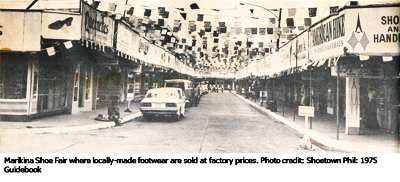 The Marikina Shoe Trade Fair where locally-made footwear are sold at factory prices
The Marikina Shoe Trade Fair where locally-made footwear are sold at factory prices
On January 30, 1967, the creation of the Marikina Shoe Trade Commission (MSTC) was approved under Mayor Osmundo de Guzman through the Administrative Order No.1, Resolution No. 12 of the Municipal Council as a means to promote the footwear manufacturing in all aspects of trade. It aims to help and subsidize the shoe industry to increase production and to promote its welfare so that those who depended on it may increase their income. Members of the commission were privileged to borrow from commercial banks as much as 90% of the assessed value of their collaterals. It also addressed the problems of the shoe industry by helping the manufacturers in formulating whatever is necessary for the continued development and progress of the industry. It also unties the stranglehold of the aliens on the marketing of Marikina shoes.
Corollary to the establishment of the MSTC, the Marikina Shoe Marketing Corporation was organized by Marikina shoe manufacturers composing the 98 percent of the stallholders at the municipal site. It was the largest distributor of Marikina footwear and it established the Marikina Shoe House in Cubao, Quezon City as its main sales outlet; the Marikina Shoe Expo, Inc., a non-stock corporation with 75 member-manufacturers; the Marikina Valley Marketing Corporation, with its marketing center at the Marikina Shoe Trade Fair; and the Marikina Shoe Crown Inc., which has its big marketing outlet in Quiapo, Manila. The Marikina Shoe Marketing Corporation assures its member of financing businesses through bank loans. It also takes care of the purchase of raw materials which are sold to members and non-members alike. These are paid back with finished products which the corporation markets to the provinces. The independent Filipino shoe manufacturers went a step forward to ensure themselves of a means for marketing and an outlet free from alien control. The Marikina Shoe Marketing Corporation was a final blow to the syndicates who used to control the shoe industry.
Mayor Osmundo de Guzman emphasized the need for education in the town’s approach toward the industry’s problems. The Municipal Government sent two scholars to Britain to study in the Northampton University to specialize in shoe manufacturing and management. In addition, the Marikina School of Arts and Trades offered a four-year specialization course in shoemaking with financial assistance from the National Manpower and Youth Council and the Marikina Shoe Trade Commission.
In 1968, Kapitan Moy’s old house was declared a National Shrine by the town council and the National Historical Commission. The ground floor of this house was converted into the first Filipino-owned leather shoe factory in the country making Kapitan Moy the first Filipino shoe factory owner. This house was also used as a public elementary school in 1912 and a venue of many social functions during the genteel prewar years.
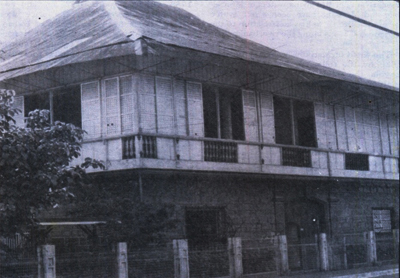
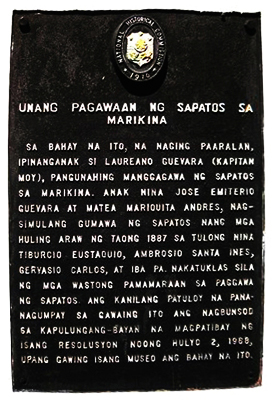 Kapitan Moy House and its marker
Kapitan Moy House and its marker
1980s: Marikina Shoes amid Trade Liberalization
Trade liberalization struck in 1980s and the advent of globalization slowed down the Marikina footwear industry. Shoe factories closed, tens of thousands of shoe workers were laid off and shoe retail shops followed the pattern of foreclosures. Only few notable Marikina brands stood tall from this circumstance causing economic recession to the town.
An attempt to organize the Marikina shoemakers was made in 1981 with the creation of the Marikina Footwear Manufacturers Exporters Association (MAFEA) with then Vice Mayor Teofisto Santos who assumed as president. MAFEA introduced modern trends of business management such as production planning, control systems and financial management. In August 1981, MAFEA participated in a shoe show in New York City and was successful in importing raw materials worth Php20 million.
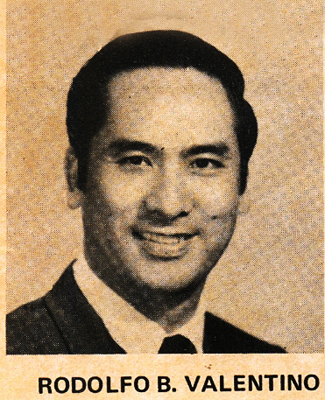
On February 25, 1987, the incumbent Municipal Mayor Rodolfo Valentino issued the Administrative Order No. 87-02 reactivating the Marikina Footwear Development Council. Its main objective was to systematize and coordinate promotion, marketing efforts and the programs of manufacturers of footwear and allied products of the town. It also launched the First Marikina Trade Festival on April 16, 1987 in which twenty-six well-known shoe manufacturers and sixteen industrial companies showcased their products.
1990s: Global Competition and Influx of Imported Shoes
Trade liberalization has allowed greater entry of imports in the country which cause local production to become more import-dependent. The shoe industry has been one of the most affected sectors due to this undertaking. In addition, the World Trade Organization (WTO) enforced rules on further tariff reduction making it burdensome for the local producers.
In 1990s, the footwear groups in Marikina and other areas witnessed the influx of cheap goods that came from China, Korea, Taiwan and other countries due to trade liberalization which further intensified when the country became a member of the World Trade Organization (WTO) in 1995. Shoe imports have been arriving in increasing volumes year after year. From 1997- 1999, the country imported an average of 38.5 million pairs of shoes. The result, from 513 registered footwear manufacturers in 1994, dropped to more than half.
In 1995, under the leadership of Mayor Bayani F. Fernando, the Kapitan Moy residence was restored to its former glory and was declared the city’s “Sentrong Pangkultura.” The Shoe Museum was then conceived in 1998 under Mayor BF on the assumption that the Marikina, being the Shoe Capital of the Philippines, can play a significant venue for nurturing the historical and cultural values of its shoe industry. And so on February 16, 2001, the Shoe Museum opened and was first called the Footwear Museum of Marikina.
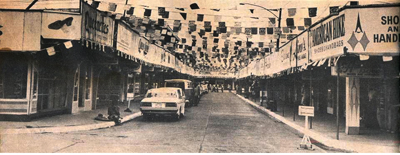
2000 – Present: Revitalizing the Shoe Industry
In December 2002, the Guinness Book of World Records recognized Marikina City for crafting the world’s largest pair of shoes. Each pair measured 5.29 meters long, 2.37 meters wide and 1.83 meters high. The heel alone measures 41 centimeters or 16 inches. The Php2 million shoes can reportedly fit to the feet of a 37.5-m (125 ft) giant. Around 30 people can put their feet into the colossal shoes simultaneously. The world’s largest shoes were made from materials that could produce 250 pairs of regular-sized shoes. It reportedly took 10 shoemakers, led by Ernesto Leano, 77 days to cut and 30 square meters of leather for the upper lining and 7.4 square meters for the sock lining. Also used were 250 kilogram of adhesive and a kilometer of thread for 200,000 stitches.
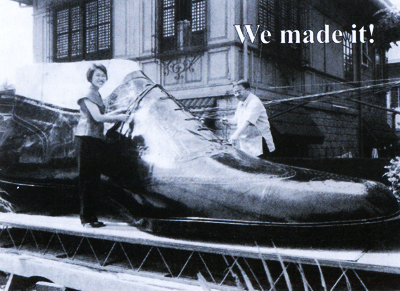 Mayor Ma. Lourdes C. Fernando and Vice Mayor Marion S. Andres
Mayor Ma. Lourdes C. Fernando and Vice Mayor Marion S. Andres
proudly unleashed the world’s largest shoes in the world
On April 15, 2004, Congressman Del R. De Guzman authored the Republic Act 9290, an Act that promoted the development of the footwear, leather goods and tannery Industries with the mandate to bring back the glorious days of the Marikina Shoe Industry when it gained respect and recognition not only in the Philippines but worldwide. The Marikina Shoe Industry Development Council (MASIDC) was also created by virtue of an Ordinance No. 50 Series of 2011 sponsored by Councilor Mario de Leon on October 3, 2011.
ABOUT THE AUTHOR: Nonet Angeles works as Librarian III at the Marikina City Library in-charge of training and assisting the library staffs in operating the department. One of her projects was spearheading the collection development, organization and digitization of the City’s local history records to pursue her vision of having an Archives Section that will preserve the vital records of Marikina’s cultural heritage. Angeles finished her Bachelor of Arts degree in Library and Information Science at the Polytechnic University of the Philippines in 1998. In 2008, she took up Continuing Professional Education at the Marikina Polytechnic College. She is presently enrolled at the Master’s degree program of the School of Library and Information Studies at the University of the Philippines Diliman under the Archives and Records Management Track.
REFERENCES
Marikina City Planning and Development Office. (2013). Facts and Figures: Marikina City 2012.
Marikina Cultural Tourism Trade and Investment Promotions Office. (2011). Marikina City Tourist Sites. Brochure.
Marikina Shoe Industry Development Council. Marikina Shoe Industry History Timeline.
Municipal Development Planning Office. (1989). Marikina. Marikina, Metro Manila.
Municipal Government of Marikina. (1975). Shoetown Philippines: 1975 guidebook. Marikina, Rizal.
Official Website of the City Government of Marikina. Retrieved August 2, 2013, from https://marikina.gov.ph/
PHOTO CREDITS
Figure 2. Marikina River – http://quod.lib.umich.edu/
Figure 3. Marikina Farming- http://quod.lib.umich.edu/
Figure 4: Old Marikina
The First Philippine Shoe Festival Souvenir Program (1969)
Figure 5. Kapitan Moy
Source: Marikina Municipal Council, & Marikina Shoe Trade Commission. (1968). 1st Marikina Shoe Trade Mission to Japan & Southeast Asia: March 18 to April 15 1968. Marikina, Rizal. Souvenir Program.
Figure 6. The Pioneers of Shoemaking that Helped Kapitan Moy.
Source: Ika tatlong daan at apatnapung kaarawan ng pagsilang ng bayan ng Marikina: Abril 16, 1630 – Abril 16, 1970; mga dahong pang alaala. (1970).Souvenir Program.
Figure 7. The Marikina Shoe Trade Fair.
Source: Municipal Government of Marikina. (1975). Shoetown Philippines: 1975 guidebook. Marikina, Rizal.
Figure 8. Kapitan Mo’y House.
Source: Municipal Development Planning Office. (1989). Marikina. Marikina, Metro Manila.
Figure 9. Marker.
Figure 10: Rodolfo Valentino
Source: Municipal Government of Marikina (1975)
Figure 11: Marikina Shoe Town Philippines
Source: Shoe Town Philippines Guidebook (1975)
Figure 9: Old Marikina
The First Philippine Shoe Festival Souvenir Program (1969)
Source: National Registry of Historic Sites and Structures in the Philippines Website. Retrieved September 9, 2013 from http://nhcphistoricsites.blogspot.com/search/label/Marikina%20City
Figure 7. Mayor Ma. Lourdes C. Fernando and Vice Mayor Marion S. Andres proudly unleashed the world’s largest shoes in the world.
Source: Public Information Office. (2003). 2nd Sapatero Festival: November 16-30, 2003, River Park, Marikina City. Marikina City. Souvenir Program.














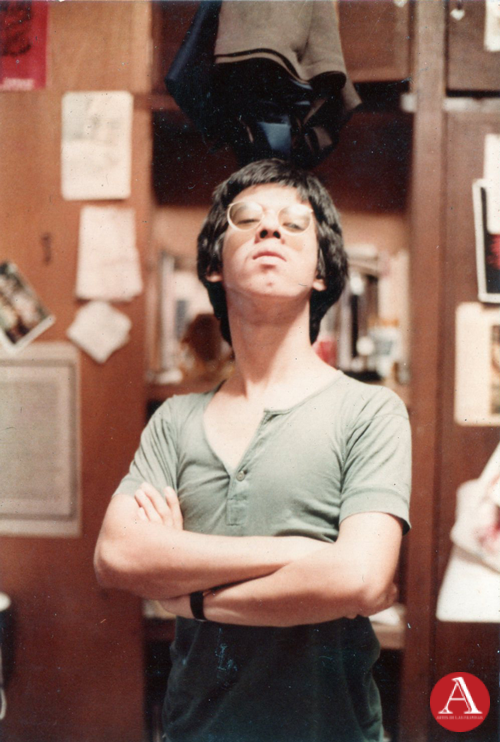 FEDERICO SIEVERT'S PORTRAITS OF HUMANISM
FEDERICO SIEVERT'S PORTRAITS OF HUMANISM.png) FILIPINO ART COLLECTOR: ALEXANDER S. NARCISO
FILIPINO ART COLLECTOR: ALEXANDER S. NARCISO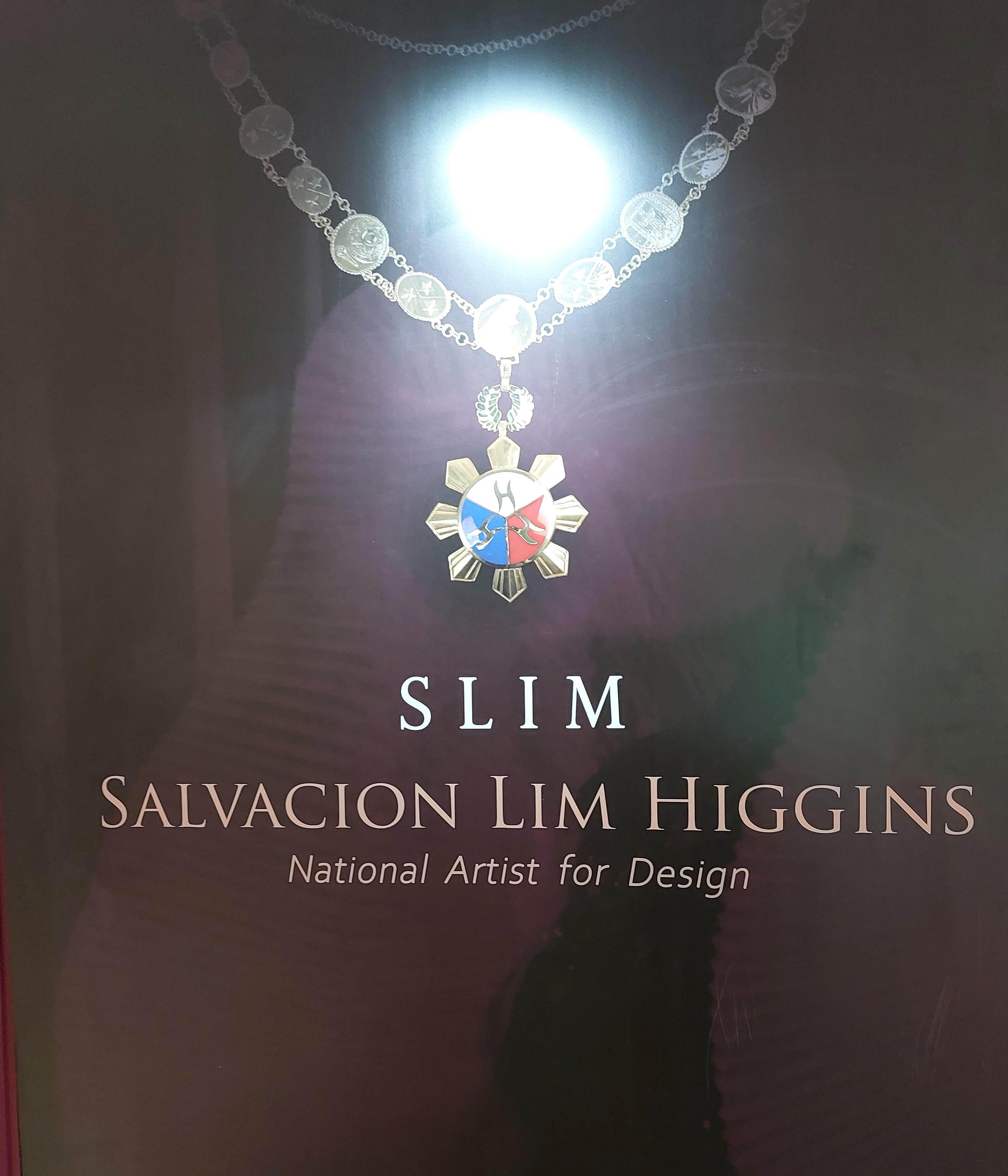 An Exhibition of the Design Legacy of Salvacion Lim Higgins
An Exhibition of the Design Legacy of Salvacion Lim Higgins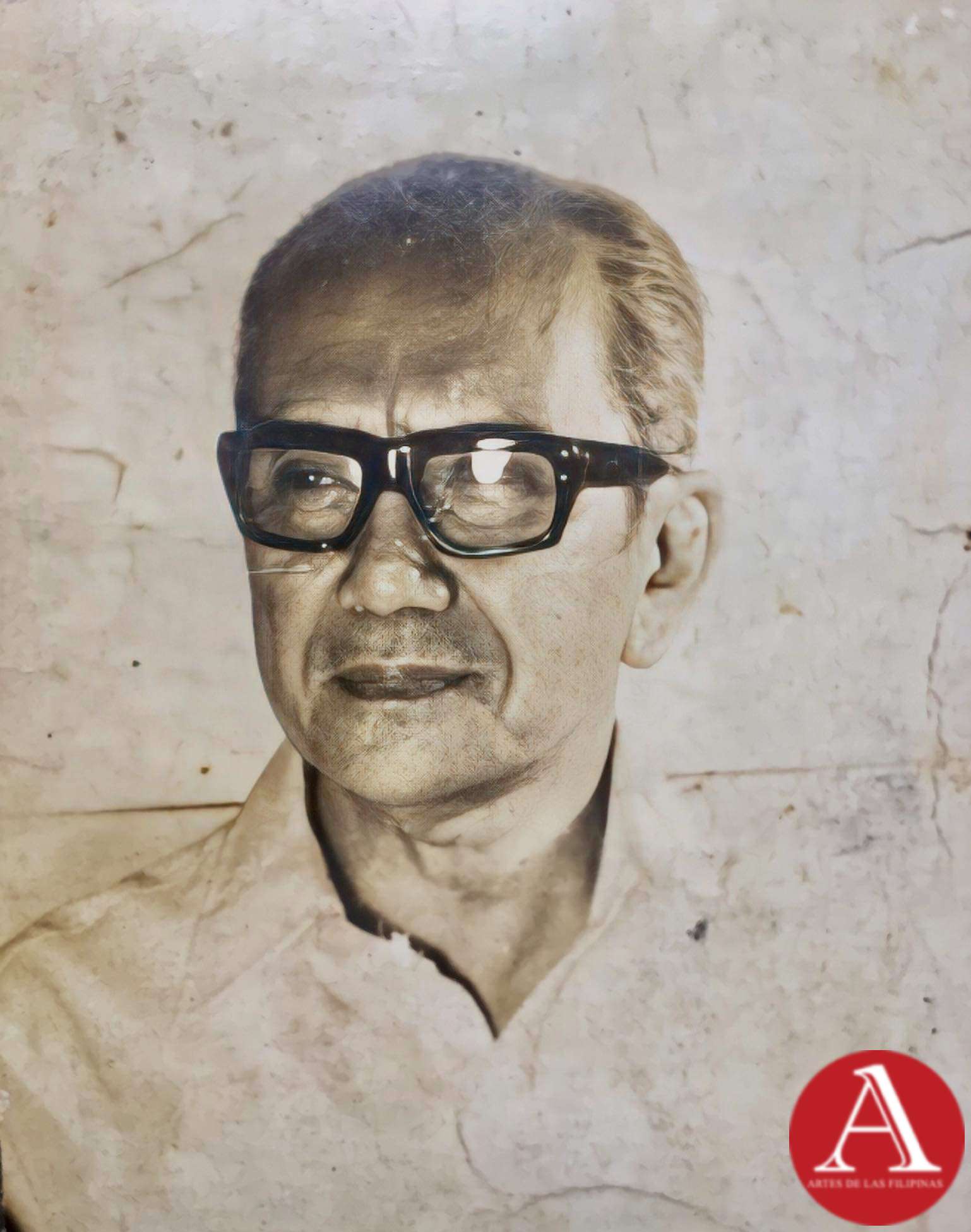 Jose Zabala Santos A Komiks Writer and Illustrator of All Time
Jose Zabala Santos A Komiks Writer and Illustrator of All Time Patis Tesoro's Busisi Textile Exhibition
Patis Tesoro's Busisi Textile Exhibition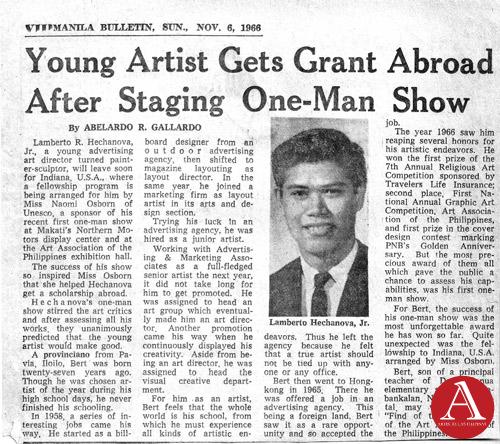 Lamberto R. Hechanova: Lost and Found
Lamberto R. Hechanova: Lost and Found European Artists at the Pere Lachaise Cemetery
European Artists at the Pere Lachaise Cemetery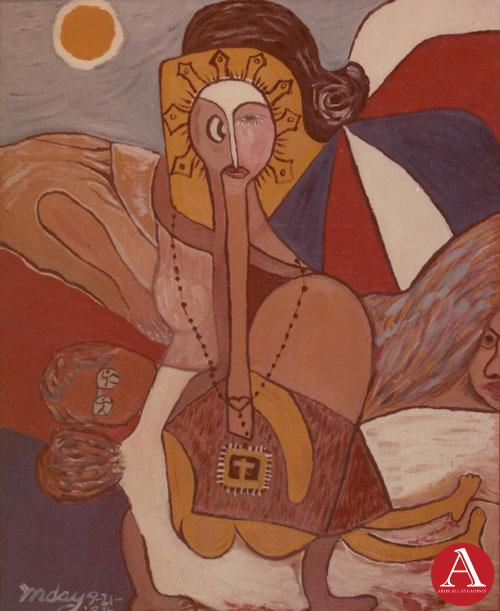 Inday Cadapan: The Modern Inday
Inday Cadapan: The Modern Inday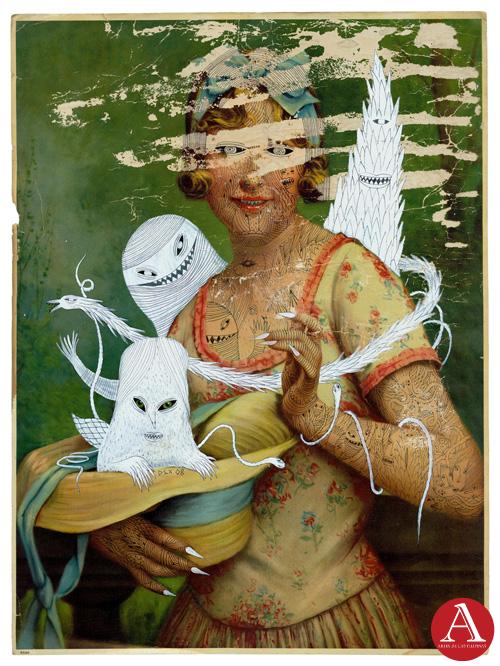 Dex Fernandez As He Likes It
Dex Fernandez As He Likes It



